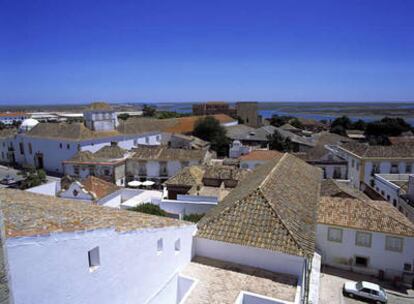Cubism, covos and cataplanas
There's much to sample along Portugal's Algarve coast in summer
The Algarve region, in southern Portugal, offers a variety of summer options, from fishing towns like Olhão to large cruise ships that follow the coastline, to havens of peace on the southernmost tip and secluded retreats for the rich and famous, including soccer's Cristiano Ronaldo.
They call Olhão the Cubist city. A look down from the church tower of the Igreja Matriz, built with contributions from local fishermen, reveals why. This town in the heart of the Algarve features 18th-century buildings that look like superimposed cubes that a giant hand managed to squeeze in between the narrow, winding Islamic-style streets. These white buildings often replace the roof with a terrace, not just to enjoy the views but also to have somewhere to dry the fruit and fish.
The touch of color is provided by the boats in the fishing port, where the daily catch includes silvery sardines and where it is still possible to see the odd covo , a traditional earthenware basket used to catch octopus. A stroll along the salt marshes takes visitors to the ruins of the watchtowers of Torre de Bias, Cumeada and Alfanxia. Near here are the Olheiros Springs, where the waters are said to have medicinal properties.
Travelers coming in by plane to Faro will know that something is up when they run into an enormous ice-cream cone made with plastic toys. Tutti-Frutti , by Joana Vasconcelos, is part of a summer art festival called Allgarve '11. But Faro, the most international city in Portugal's southern tip, has many other eye-catching attractions, such as the ninth-century walls built by Muslim prince Ben Bekr, or its five sandbars shaped like islands. Arab and medieval constructions share space, and the cathedral is considered one of the most significant buildings from the 17th and 18th centuries.
Just a few kilometers out of Faro, Cerro da Vila preserves its Roman legacy. The Ruins of Milreu are what's left of a luxury country villa that became a religious building at the service of the Catholic Church in the sixth century.
The heart of Vilamoura holds remains of another Roman construction that had thermal baths and tanks for salting fish in the first century AD. The lively beach of La Falesia is the starting point for short boat trips that sail along the coast in the daytime. There are stops at semi-deserted beaches, outdoor meals consisting of fresh grilled sardines, and diving expeditions. From a ship, it is possible to appreciate the sinuous outline of the coast and the deep blue tone of the sea.
From August 31 to September 3, Vilamoura also hosts a ' cataplana ' competition to encourage the use of this typical Algarve cooking utensil. Forty local restaurants create dishes using the Portuguese version of Spain's paella pan, producing rice and seafood platters and succulent clams that still smell of the sea.

Tu suscripción se está usando en otro dispositivo
¿Quieres añadir otro usuario a tu suscripción?
Si continúas leyendo en este dispositivo, no se podrá leer en el otro.
FlechaTu suscripción se está usando en otro dispositivo y solo puedes acceder a EL PAÍS desde un dispositivo a la vez.
Si quieres compartir tu cuenta, cambia tu suscripción a la modalidad Premium, así podrás añadir otro usuario. Cada uno accederá con su propia cuenta de email, lo que os permitirá personalizar vuestra experiencia en EL PAÍS.
¿Tienes una suscripción de empresa? Accede aquí para contratar más cuentas.
En el caso de no saber quién está usando tu cuenta, te recomendamos cambiar tu contraseña aquí.
Si decides continuar compartiendo tu cuenta, este mensaje se mostrará en tu dispositivo y en el de la otra persona que está usando tu cuenta de forma indefinida, afectando a tu experiencia de lectura. Puedes consultar aquí los términos y condiciones de la suscripción digital.








































